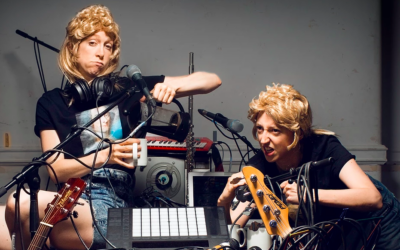We heard a lot over the course of the Aural/Oral Dramaturgies project about how radio as a medium has enjoyed a huge resurgence. While an interest in radio was already boiling under the surface pre-pandemic – think of the many community radios that have popped up thanks to the potentials of internet broadcasting and of the steady rise over the 2000s of podcast culture – we have allegedly witnessed a much-needed shift now from radio as a ‘me culture’ (closer, I venture, to the world of YouTubers and reality TV) to radio as an ‘us culture’, concerned with creating a shared space aided by the intimacy of the non-scopic.
‘Company’ is a key word now, and has undergone a slight semantic alteration in our everyday discourse, returning referentially to a more solitary and quieter dimension of existence; in this new, but old, arrangement, we might have temporarily put to one side an idea of broadcast media as necessarily connected to the chatter and clatter of public discourse – the system of disruption, distraction and interference that has haunted much postmodern discourse and extended into our ‘post-truth’ world – to sink for a moment into the comforting idea of a broadcast medium that can score the day, keep you warm, lull you to sleep. Ella Finer and Urok Shirhan’s Salon ‘Companion Sounds’ explicitly addresses the economies of attention of radio and of how presence and absence, background and foreground, solitude and togetherness function in radio broadcast as a mode. Crucially, Finer and Shirhan’s conversation stages a deep interrogation of media broad and narrow, departing from two rich and thoroughly strange starting points: on the one hand Zoom culture, just nascent at the time of the recording in June 2020, and the idea of the ‘meeting’ which may not be a meeting at all if it involves hundreds of people; on the other, the experience of receiving Covid-19 text message alerts from the Greek government while the two were on residency together in Athens, with ‘everybody’s phones pinging at once’. In the background of this conversation, the economies of private and public space are constantly engaged: listening to something at home, going to something in public, confronting the fact of seeing and being seen versus private and unshared engagements, modalities of focus and attention.
Companionship is central also to the work of She Goat, who contribute both a Gallery and a Laboratory to this collection which allow us to observe an interesting twist on the topic, especially if you listen to them back to back. Their show The Undefinable began its life as a live performance utilising the staging device of a late-night radio phone-in as intimate yet distant context par excellence and became an actual podcast series following the pandemic, illuminating the questions the duo had about radio vs. performance from the other side. We might have a productive time then thinking about what live performance subtracts from radio, rather than what it yields, and about what existing ‘as sound only’ lends to theatre and performance as representational modes. We might also have a provocative time thinking about such matters: might we use the historical contingency of Covid-19 to reflect on a new theatre that thrives on absences and distances? Might it be useful to interrogate the presence of the live body on stage as a default, or even a fetish? If the theatre is in itself a technology or a ‘machine’, might the experience of the pandemic productively destabilise hierarchies of the live and the recorded, the visual and the sonic, the unmediated and the inescapably media-bound?
These are ongoing debates, and Farokh Soltani’s Library about his excellent 2020 book Radio/Body asks these and other wild questions about radio and radio drama, but pushes the debate even further, positing radio as a listening body in and of itself: ‘When I listen to a piece of radio drama, I am listening to the bodily experience of an other, and that other I absolutely only encounter through radio. Even though I know that the radio is just a device, the moment I listen to the radio, the radio is no longer the radio, it is a radio body’ (LMYE Library #2 2021: 5).
Works Cited
Radosavljević, Duška; Pitrolo, Flora; Salazar Cardona, Juan Felipe; Soltani, Farokh (2021) LMYE Library #2: Farokh Soltani – Radio/Body (2020), Auralia.Space, Royal Central School of Speech and Drama, https://doi.org/10.25389/rcssd.14014055.v1.
Soltani, Farokh (2020) Radio/Body: Phenomenology and Dramaturgy of Radio, Manchester: Manchester University Press.





